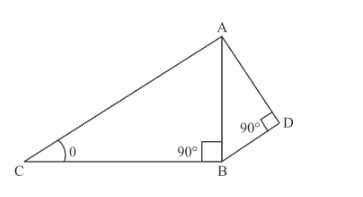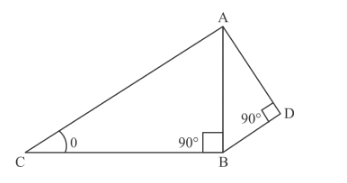Question:
In Fig. 3, AD = 4 cm, BD = 3 cm and CB = 12 cm, then cot θ equals
(a) $\frac{3}{4}$
(b) $\frac{5}{12}$
(c) $\frac{4}{3}$
(d) $\frac{12}{5}$

Solution:
In Fig 3, if we have
AD = 4 cm,
BD = 3 cm, and
CB = 12 cm, then
cot θ = ?
We have the following diagram

If we apply Pythagoras theorem in triangle ADB, we get
hypotenus $=\sqrt{(\text { base })^{2}+(\text { perpendicular })^{2}}$
$\Rightarrow \quad A B=\sqrt{(B D)^{2}+(A D)^{2}}$
$\Rightarrow \quad A B=\sqrt{3^{2}+4^{2}}$
$\Rightarrow \quad A B=5$
Now,
$\cot \theta=\frac{\text { base }}{\text { perpendicular }}$
$=\frac{C B}{A B}$
$=\frac{12}{5}$
Hence the correct option is (d).
Click here to get exam-ready with eSaral
For making your preparation journey smoother of JEE, NEET and Class 8 to 10, grab our app now.
